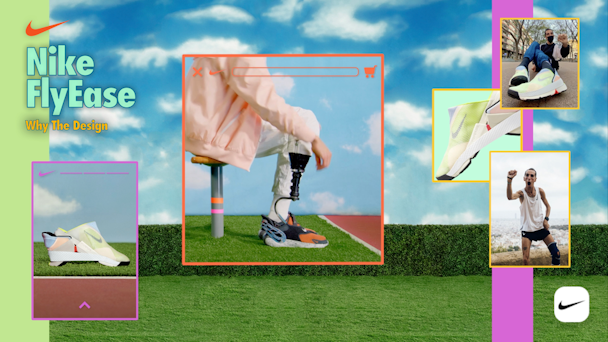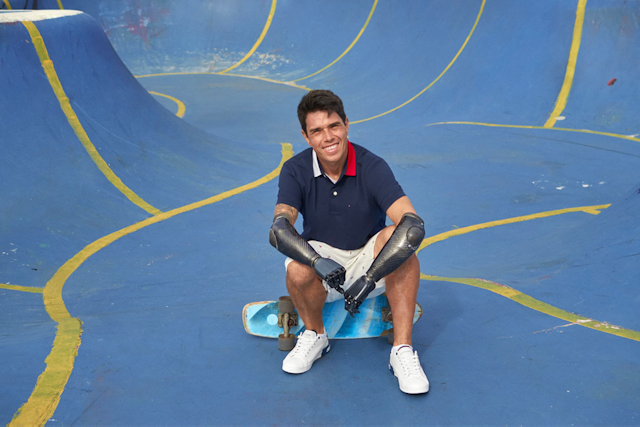Sports marketers must ensure the representation of adaptive athletes
People with disabilities and adaptive athletes are still underrepresented in sports marketing. For The Drum’s Sports Marketing Deep Dive, Sofia Ewuraesi Bodger, senior strategist at AnalogFolk Amsterdam, looks at the brands at the forefront of change, and how to follow suit.

Analogfolk looks at how brands can be more inclusive of sportspeople in campaigns / Nike FlyEase, Why The Design Campaign
While the global sports market has reached a value of $388bn, Nielsen has reported that just 1% of this goes to spend on ads that feature adaptive athletes or are inclusive of disability themes in creative. Although fashion brands such as Tommy Hilfiger and Louis Vuitton are paving the way forward to include different abilities in the D&I conversation, there are missed opportunities for the inclusion of all ability stories in sports marketing and beyond. Brands and marketers have a responsibility to make this happen.
The Paralympics and Invictus Games have both been shown to have had a positive impact on the coverage of adaptive athletes in the media, changing attitudes and neutralizing the difference in coverage. But when it comes to brands, there is little support.
The power of narrative
For a long time, adaptive athletes have been overlooked and underrepresented in mainstream media. Progress on improving disabled representation in sports has been slow, and when adaptive athletes are represented we continue to see prejudice and stereotypes.
One of the most common stereotypes is the ‘supercrip narrative,’ which foregrounds triumph over adversity and frames disability as an individual problem a person must ‘overcome.’ Unless brands create inclusive stories that incorporate themes beyond an athlete’s disability, moving beyond the supercrip myth, the industry will continue to perpetuate dominant stereotypes.
As wheelchair fencer Bebe Vio told Nike: “I love being a Para-athlete, just because I love the world in which I’m living, and I love knowing all the stories of every kind of athlete.”
Branded storytelling has the potential to be the catalyst for inclusion and representation. “All the stories of every kind of athlete” are still waiting to be told.
Addressing that 1%
So how can sports marketing create accessibility and exposure for adaptive athletes? To create a culture of inclusion and increase the abysmal 1% of spend, we need to change today’s media approach, shift power and elevate those whose stories have yet to be told. Brands must find narratives that authentically connect to athletes’ stories, to collaborate and connect with partners within the all-ability community and incorporate themes beyond an athlete’s disability. This will speak to them in a more authentic way, to their interests, and enable the neutralization of difference while still acknowledging their disability.
One brand acting on this is Nike. The release of FlyEase ‘hands-free’ shoes is one of the biggest innovations in the brand’s history, a product that embodies ‘if you have a body, you’re an athlete.’ It’s a life-changing innovation for athletes of all abilities.
But when FlyEase first launched, the product immediately sold out to resellers. Co-opted by sneakerheads, FlyEase was difficult to access for those that needed it most, resulting in disappointment and negative sentiments from the disability community.
Adapting its approach, Nike partnered with adaptive athletes for the following FlyEase launch with a campaign to educate the sneaker community about the technological benefits of FlyEase. They brought to life the impact of the product in their sports life to Nike’s broader athlete community.
We at AnalogFolk Amsterdam collaborated with Nike on the campaign. Executive creative director Carren O’Keefe says: “We wanted to go beyond just saying who the FlyEase innovation is for – and actually show it. We took the iconic ‘Behind the Design’ content series, a sneakerhead favorite, and reframed it to ‘Why The Design’ to not only show why it’s so innovative, but also why it’s designed for adaptive athletes. Influencing hypebeasts into NOT buying the shoe to get it on to the feet of the people who need it the most.”
In a widely-shared statistic, Coresight Research put the potential market value of adaptive design at $64.3bn. Mainstream brands have been slow to embrace adaptive design, but – like Nike – Tommy Hilfiger is paving the way forward to include different abilities in the D&I conversation. In 2016, they launched The Tommy Hilfiger Adaptive Collection. It aims to transform how fashion defines diversity by serving the needs of people with disabilities.

Source: Tommy Hilfiger, Spring 2021
It’s time for brands to use their collective voice and position of privilege as a tool to shift the 1% and create the representation and inclusion needed.
Inclusion and representation of all stories is key. Make diversity and inclusivity agendas the ‘norm,’ not just a ‘trend.’ Integrate adaptive stories authentically. Include and integrate them across all campaigns v singling them out as hero pieces. Here are four other things your brand can do:
-
Shift from the sidelines to the starting lines
Brands have a responsibility to shift from a culture where adaptive athletes are sidelined to an inclusive culture that puts adaptive athletes at its heart. Show adaptive athletes together with other athletes as equals, illustrating their role and value within the sporting community.
-
Ensure authentic storytelling
Find multi-dimensional narratives that authentically connect with athletes’ stories and address roles beyond athleticism. Pay close attention to casting choices, authentic storytelling and camera angles.
-
Lead with adaptive; represent dual ability
There are many different types of disabilities, both physical and cognitive. Not all disabilities are visible. From mobility to congenital limb difference, ensure all disabilities are represented in casting.
-
Remember it is the responsibility of all marketers to address imbalance
It’s not the responsibility of people with disabilities to address the imbalance in representation. To make a genuine difference and create inclusion for all abilities in marketing, it’s every marketer’s responsibility to create multi-dimensional narratives that are inclusive and representative.
Check out The Drum’s latest Deep Dive, The New Sports Marketing Playbook, and learn the tactics employed by the world’s biggest sports organizations and their star athletes to stay at the top of their game.
Content by The Drum Network member:

AnalogFolk
Our mission is to use digital technology to make the analog world better and to also be an impactful agency of change for people, brands and society, in pursuit...
Find out more
